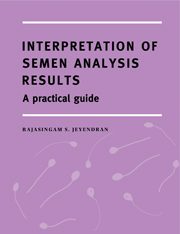Book contents
- Frontmatter
- Contents
- Preface
- Introduction
- Hypotheses on fertile ejaculate identification
- Male reproductive system background
- Semen analysis interpretation
- ROUTINE SEMEN ANALYSIS
- SPECIALIZED SEMEN ANALYSIS
- The logical sequence of routine and specialized semen analysis
- Semen component point-of-origin
- Conclusion
- Standard semen variable reference values for clinical interpretation and diagnosis (Table 1)
- Specialized semen test reference values for clinical interpretation and diagnosis (Table 2)
- Spermatozoa biochemical analysis and seminal plasma chemical analysis reference values for clinical interpretation and diagnosis (Table 3)
- Glossary
- Suggested additional reading
- Index
Hypotheses on fertile ejaculate identification
Published online by Cambridge University Press: 05 August 2016
- Frontmatter
- Contents
- Preface
- Introduction
- Hypotheses on fertile ejaculate identification
- Male reproductive system background
- Semen analysis interpretation
- ROUTINE SEMEN ANALYSIS
- SPECIALIZED SEMEN ANALYSIS
- The logical sequence of routine and specialized semen analysis
- Semen component point-of-origin
- Conclusion
- Standard semen variable reference values for clinical interpretation and diagnosis (Table 1)
- Specialized semen test reference values for clinical interpretation and diagnosis (Table 2)
- Spermatozoa biochemical analysis and seminal plasma chemical analysis reference values for clinical interpretation and diagnosis (Table 3)
- Glossary
- Suggested additional reading
- Index
Summary
The primary purpose of semen analysis is the determination of spermatozoon fertility potential. Such interpretation and fertility potential determination involve different conceptual frameworks. To enhance overall understanding of interpretative procedure and its interrelationship with sperm fertility potential, consider the following conceptual outline:
Although the fertilization process is fairly well understood, existing scientific knowledge provides few specific parameters regarding the fertilizing capacity of any particular ejaculate. Granted, an infertile ejaculate can be identified with some facility and certainty when one sperm parameter is significantly or absolutely abnormal. Realistically, the spermatozoon is an extremely complex cell that becomes infertile when any one of a number of highly sensitive biochemical, physiological or morphologic entities is disturbed. Such complexity makes fertilization evaluation even more difficult when one or several of these attributes deviate only slightly from the statistical mean.
The goal of semen analysis, ultimately, is to evaluate whether an ejaculate is potentially fertile or not. Conducting a large battery of assays will ensure some degree of certainty. Unfortunately, the interpretative challenge then becomes which of the many available assays should be performed.
A single test assay capable of identifying several different sperm attributes would be ideal. In fact, such assays are available, mainly as sperm processing procedures for IUI and other assisted reproductive technologies. For example, any routine sperm selection technique such as the Swim-Up Method, washing through density gradients (colloidal suspension of silica particles, Nycodenz), or adherence column filtration methods (glass wool or Sephadex) yields a sperm subpopulation with significantly higher quality. The sperm obtained as a result of utilizing these techniques generally improves several sperm attributes to the point of reaching (or satisfying) reference value criteria for different sperm variables. Further research and development on these unconventional fertility evaluation procedures are needed either to standardize and establish routine sperm test assays, or to improve or abandon them when experience renders them useless.
To complicate matters further, a majority of sperm in any given ejaculate cannot be absolutely classified as either normal or abnormal. Sperm morphology can vary from virtually flawless to unequivocally abnormal, with a broad range in-between. Similarly, ‘normal’ sperm motility has differing motion characteristics, including various degrees of functional forward progression.
- Type
- Chapter
- Information
- Interpretation of Semen Analysis ResultsA Practical Guide, pp. 5 - 8Publisher: Cambridge University PressPrint publication year: 2000



